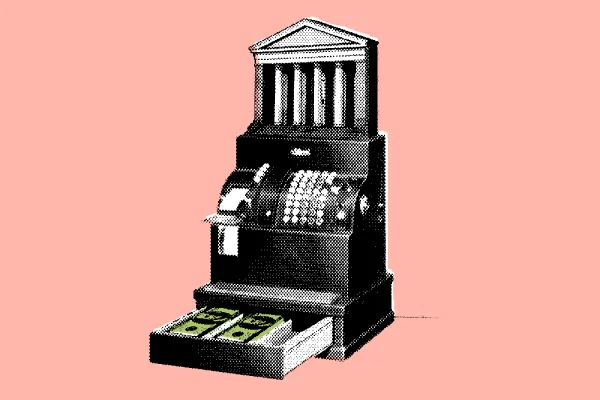
Illustration by II
Due diligence is as much about process as art. In trying to select which alternative investment managers to work with, due diligence professionals must analyze many characteristics, all with the intent of finding the perfect partner. However, most things a due diligence analyst digs into represent a series of trade-offs, balancing the pros versus the cons. There often is no right or wrong answer to many of them.
Take, for one, the size of a fund. Is it better to be big or small? The answer is often that it depends.
The manager of a very small fund can often be nimble and invest in smaller-capitalization stocks or off-the-run opportunities that larger managers can’t touch. Moreover, with smaller funds, managers can generally enter and exit positions much more easily, without creating the type of market impact that degrades returns. Most $20 billion funds will acknowledge that they don’t get out of bed unless a trade has $200 million worth of capacity for them, which is just a 1 percent position; they would have to do 100 of those trades just to deploy the entire fund.
Conversely, that $20 billion fund manager will have an enormous team of investment professionals capable of cranking out staggering amounts of research that can provide an edge in complex transactions. The big fund will also be more relevant as a funding source to large corporations or as a counterparty to investment firms on Wall Street. For big, complex transactions, the larger fund is more likely to get exclusivity or preferential terms and access. These managers are going to get the first call on a $1 billion transaction. The $200 million fund won’t even see the deal.
Both managers can play to their relative advantages, but neither one is without its own related risks. Smaller funds tend to have wider dispersion of returns — a higher probability of really strong or really bad numbers — whereas larger funds should provide more-consistent returns. Conversely, a bigger fund will usually have more line items — greater complexity — making it harder for clients to get a complete handle on a portfolio.
There is a great deal of research on fund size, and even after all the results are in, it’s not exactly clear which profile is better in total. So what probably matters more to asset owners are the investment constraints and other risks expressed in an allocator’s portfolio. No size is perfect, but any size could be the perfect fit.
There are other, similar topics that have been the subject of much debate, but one factor that hasn’t been broadly discussed is decision attribution. In some ways, decision attribution is the inverse of key-person risk.
To understand what I mean, let’s first define “key-person risk.” The term refers to the reliance of an investment process on the decision making of one or more key individuals. Ostensibly, these people have differentiated skills, experiences, and knowledge that allow them to make superior investment decisions. The fewer individuals that oversee an investment decision, the greater the reliance on any one of them.
Although most limited partnerships have key-person clauses, which describe what happens in the event key individuals are no longer able to fulfill their duties, that particular lever of risk management doesn’t address decision risk under normal operating circumstances. For example, a fund with a sole portfolio manager is almost completely dependent on his or her judgment at all times. A single manager in this situation can often do whatever he or she wants, for good or for bad. Solo managers may even deviate from investment guidelines, with investors in the dark about the rationale for any given investment. That’s because the decision is based on a combination of objective research and the portfolio manager’s personal biases, preferences, and emotions — at least to some extent.
A recent example of this key-person risk appears in the story of once–star manager Neil Woodford, who shifted his eponymous Woodford Equity Income Fund aggressively into early-stage, unlisted companies, a move that both surprised investors and created a liquidity mismatch with the fund terms. After investor redemptions caused a suspension in the fund, the ensuing liquidation by the fund’s administrator left investors nursing heavy losses.
On the other hand, an investment committee made up of multiple members will of course be less dependent on any single one of them. But that’s the problem. The old folk saying “Too many cooks in the kitchen spoil the broth” has some solid basis in social psychology. The term “social loafing” describes the propensity of individuals to exert less effort as part of a group than when working alone. When members of a group work collectively to achieve a common goal, each member of the group feels less need to contribute than they would if they were individually responsible for the outcome. The effect is more pronounced as groups get bigger.
This finding is also known as the Ringelmann Effect, named for French engineer Maximilien Ringelmann. While performing research into group productivity, Ringelmann discovered that the bigger the group, the lower the individual productivity. In his experiments, participants were asked to pull on a rope attached to an agricultural tool. Comparing the force of different groups, Ringelmann documented that two individuals pulling the rope exerted only 93 percent of their individual efforts, three individuals contributed just 85 percent of their individual abilities, and groups of eight applied a mere 49 percent of their individual efforts. The whole was increasingly less than the sum of its parts. In total, the work of the largest group represented the full efforts of only four people.
An analogous effect has been found in private equity. Research by French economist Ludovic Phalippou and two other authors found significant diseconomies of scale in private equity firms. Put another way, returns dropped as a firm grew. However, these researchers linked the diseconomies of scale not just to asset growth, but directly to the organizational hierarchy of the firm. Smaller and flatter governance structures performed better than large and complex committees. Similarly, research in the Journal of Financial Economics on the financial performance of public companies shows that businesses with small boards outperformed those with large boards across every financial ratio measured.
In practice, big committees diffuse the risk of any one individual, but they also diffuse the responsibility of each person. Further, they make it a lot harder to know who is actually adding — or detracting — value. I’ve experienced numerous instances where a firm represented a certain member of the investment committee as highly critical to the process during my diligence. Then when that person left, the firm backtracked on how important he or she was to the overall process. “The committee is very deep; they won’t really be missed,” I have often heard after having already invested. Though the committee process is intended to provide continuity in decision making, investors can’t truly know how it works in practice.
So how can we balance the decision attribution certainty of a sole decision maker with the checks and balances that come with a broader committee — without giving up the potential for excess returns? What’s the appropriate mix of these factors?
I’ve personally always favored a dual-portfolio-manager approach, having had success with it in the past. But I’m never one to settle for an anecdotal answer to a problem, so I set out to discover what the research says.
Thankfully, I found the answer in work from investor, author, and behavioral finance guru Michael Mauboussin. Mauboussin conducted an analysis comparing the returns of similar mutual funds, categorized by the number of final decision makers. Funds with a sole-portfolio-manager structure served as the baseline. Mauboussin then compared their returns with those of investment committees with two, three, four, or more members.
He discovered that all of the funds that had multiple people involved in investment decisions outperformed the single-PM model, but that those with three had the best-performing arrangement. Having three people on an investment committee was better than having either two or four members.
Why is three the best number? Mauboussin argues that three people provide better debate and vetting of ideas than two people. Plus, it’s an odd number. A dual-decision-maker structure generally requires consensus, but consensus shouldn’t be the benchmark for a good decision. Being right should be — and sometimes, being right requires debate and discomfort. But with more than three people, with ever bigger committees, social loafing increases and the Ringelmann effect begins to overwhelm the value of additional participation.It’s rare that an unambiguous answer presents itself in these manager selection trade-offs. Although there will always be exceptions, in this case, Mauboussin may have offered up the perfect compromise. Whereas having two decision makers could be too much key-person risk, and four or more too many cooks in the kitchen, three portfolio managers might be just right.





